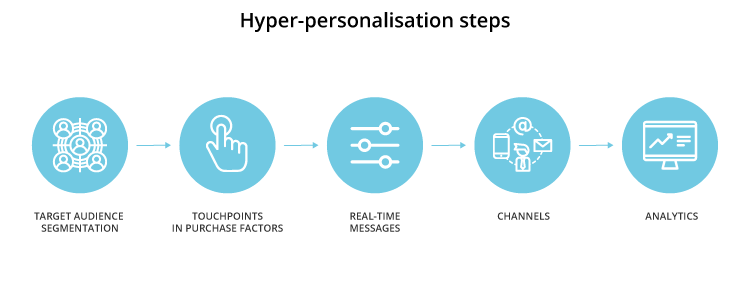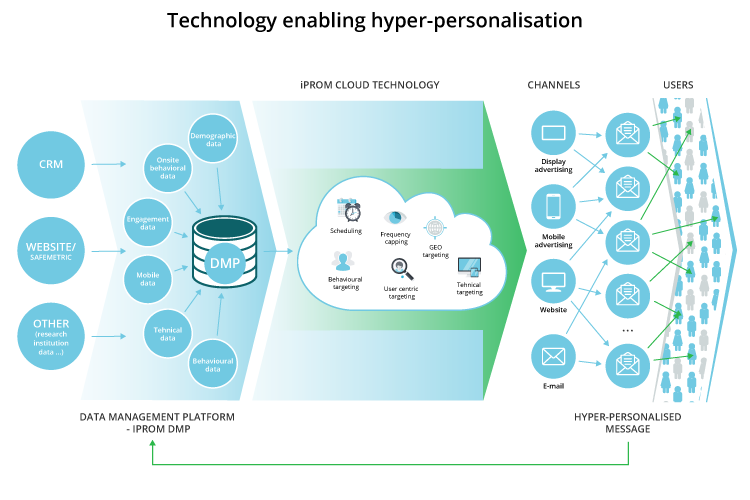Hyper-personalisation is becoming a key formula for the success of efficient advertising campaigns. Do you know what is hiding behind this notion?

In my first article on hyper-personalisation, I wanted you to become familiar with the concept and with its advantages; in this article, I would like to focus on how to implement it.
The backbone of hyper-personalised communication is a marketing strategy that relies on collecting data from each point of contact at all times. Personalised communication is upgraded through machine learning technology, defining a whole new level of the way in which personalised advertising messages are delivered.
Hyper-personalisation is composed of five main components, each of which adds something to the whole. Data, consumer insight, and the development of a multi-channel strategy are interconnected areas which represent the basis for the implementation of hyper-personalisation. The aforementioned elements therefore depend on one another and are based on data which make it possible for us to obtain an insight into the consumer and, later, to create the basis of multi-channel strategy.
Hyper-personalisation steps
Hyper-personalisation requires a well-integrated framework of several technological tools and processes in order to achieve the desired targeting results in real-time, which are based on the decision journey of the consumer.

The first step is to collect the right types of data, since the hyper-personalisation strategy will only be as good as the quality of the collected data. The more information you have, the higher number of segments of the target audience that will be targeted for different reasons (customer retention, cross-selling practices, etc.) you can create. With good segmentation, we therefore get a clearer insight into their needs, which makes it possible for us to better respond to points of contact in their decision journey and, in turn, influence their purchasing decisions. An insight into the consumer tells us their preferred way of communicating with the brand and informs us of the most efficient channels and devices.
On the basis of a predetermined strategy, we can deliver personalised messages (e.g. special offers to retain customers, messages for celebrating certain achievements that lead to sales opportunities/cross-selling practices, messages intended to reinforce our relationship with them, etc.) to consumers during special events (e.g. a purchase exceeding a certain value, a customer who publishes a negative review, or a risky client whose contract is nearing its termination). Together with these messages, the channels through which the advertising message will be delivered to the consumer in real time is also determined. This decision can be based on the past interactions of the consumer through various channels, the degree of their clicks, the limits of our media budget, etc.
In order to guarantee the implementation of this service to the fullest possible extent when it comes to using media assets, such campaigns must also constantly be optimised based on predetermined KPIs while collecting and analysing data related to consumer response and constantly directing any insight into these interactions back to the decision algorithms in the iPROM Cloud.
Technology enabling hyper-personalisation
Within iPROM, we collect data on web contents consumed by the user, the time, location, and device they consume them on, and the promotional content they react to. These parameters are collected in the iPROM DMP data management platform where they are also systematically processed using advanced algorithms in real-time. This enables an exact segmentation of the target audience based on different consumer characteristics, which allows us to subsequently target them through the iPROM Cloud, thus communicating with them in the correct manner, with the right advertising message, through the right channel, which increases the possibility for the conversion, i.e. for achieving our goal.
Whenever necessary, targeting data can be enriched by using activity data collected from the user’s website and from different CRM systems, such as online shops, by monitoring conversions and other matrices, etc., thus ameliorating the efficiency of advertising campaigns.

Through the iPROM Cloud, we also collect data from the other side, i.e. data on interactions with consumers through advertising campaigns, consumers’ activities when browsing the website, their purchase history, etc. By analysing them through machine learning algorithms, we define the most efficient steps to be taken in the future, as well as messages allowing us to secure the attainment of our objectives.
Here is an example of the aforementioned strategy: the website XY selling sports equipment started using hyper-personalised communication with its consumers in order to increase the degree of conversions. The consumer XY who is otherwise not a client of the XY store selling sports equipment was recently reading camping-related content online.
This event is recorded, and the anonymised identity of the consumer is connected with the behavioural pattern of “a camping enthusiast”. This information is then transferred to the iPROM DMP Data Management Platform which immediately updates the existing consumer segment of “buyers of camping products” by including the anonymised identity of the consumer into the segment.
As a result, the consumer XY is now seeing ads from the website XY proposing camping tents in the advertising banner on another website that said consumer visits a couple of moments later. The consumer XY clicks on the advertising banner and is immediately rerouted to the webpage displaying the camping equipment catalogue of the website XY. Then, the consumer finds a tent to their liking and continues the purchase.
The content management system (CMS) powering the website contains an integration (code) which uses the API program interface to create a new database profile in the iPROM Cloud, which is also updated with the event on the activity of the consumer, i.e. the purchase of a tent.
In the following step, marketing automatization can take place in order to try and increase the possibility of cross-selling practices based on this event. For example, the consumer XY receives a personalised e-mail offering them a 10% discount on other camping gear. When the consumer XY clicks the CTA button in the e-mail, they are then redirected to the sports equipment website XY where they can find all camping essentials and take advantage of the 10% discount.
As we can see from this example, hyper-personalisation provides for better conversion rates, increases the degree of web purchases and, most importantly, ameliorates the degree of sympathy towards a brand.
